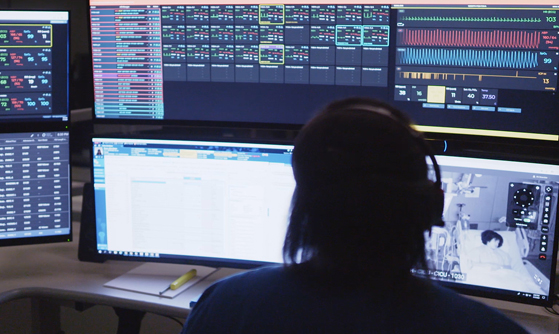INTEL HELPS HOSPITALS INSTALL COVID-19 REMOTE MONITORING
- May 5, 2020
- imc

As part of its $50m pandemic response, Intel is working with Medical Informatics on a programme that helps hospitals rapidly install and scale the Sickbay platform, an FDA-cleared clinical surveillance and analytics platform created for ICUs.
The software-based monitoring and analytics platform is vendor-agnostic, integrating seamlessly with medical devices that hospitals use.
The platform is designed to help hospitals rapidly expand intensive care unit (ICU) bed capacity and create more efficient care of the most critical patients while also reducing risk of Covid-19 exposure for critical care providers who are at a higher risk of exposure due to the nature of their work.
Through the scale to serve programme, Intel has agreed to fund the implementation fees and Medical Informatics will waive the first 90 days of software subscription licensing fees for the first 100 hospitals that qualify.
“Intel technology has a role to help accelerate the core capabilities our medical community requires to combat Covid-19,” said Lisa Spelman, Intel corporate vice president. “This is why we’re committed to applying our technology to helping protect our front-line healthcare providers who are providing care for ICU patients by accelerating the access to virtual patient monitoring. This improves the efficiency of ICU patient care from anywhere while protecting the health of caregivers on the front line of this crisis.”
Hospitals are facing challenges due to the pandemic, from ramping ICU capacity and staffing the front lines to getting providers access to the data they need to intervene effectively. They are challenged with meeting these needs because patient data are currently tied to medical devices at the bedside and locked down in proprietary formats that don’t easily integrate with each other.
The Sickbay platform helps address these issues by unlocking and unifying these disparate data from the bedside to enable flexible, scalable remote monitoring from any web-enabled device to create clinical distancing and help protect providers from exposure to Covid-19.
This means hospitals can turn any acute care bed into a monitored ICU bed in minutes and create flexible remote workflows, including the ability for one provider to direct care remotely for up to 100 patients in a single dashboard or virtual ICU (vICU) and create flexible virtual rounding of patients from conference rooms, offices or home on any PC.
This flexibility helps hospitals rapidly expand staff capacity, including staff that may be in quarantine or coming out of retirement, to get more eyes on patients and help hospitals save more lives, both from patients and healthcare workers. Remote views bring together data from multiple medical devices, including ventilators and cardiac monitors from different vendors, to ensure that all members of the care team have the data they need to take action.
“In healthcare today, less than 1% of the data being generated by patients make it into the electronic health record, forcing clinicians to work without a complete picture,” said Emma Fauss, chief executive officer of Medical Informatics. “We unlock those data to allow for predictive analytics, remote patient monitoring, AI and machine learning applications that will ultimately help providers create a new standard of care tomorrow. What Covid has done is crystallise the immediate need around reducing interactions in the room and looking at resource limitations in a new way. How can you monitor more patients with less, without sacrificing the quality of care? It requires being able to monitor patients remotely, monitor multiple patients at once, and leverage data for patient trajectory, analytics and risk scoring.”
She said that scale to serve embodied what Medical Informatics and Intel believed.
“We’re here to serve healthcare providers on the front line to do their job effectively,” she said. “We want to be there to support that mission and ultimately transform the standard of care.”
In March 2020, Houston Methodist Hospital deployed Sickbay as part of its telehealth initiative to create a vICU. Within one day of go-live, Houston Methodist began to see Covid-19 patients. Due to Sickbay’s software-based design, it was able to turn on new Covid-19 ICU beds in minutes. The hospital’s staff has the ability to monitor up to 180 Covid-19 patients remotely from their on-site command centre, conference rooms and offices. Other Medical Informatics clients are also beginning to expand capacity for Covid-19, including the University of Alabama at Birmingham Hospital.
“We plan to use Sickbay in a centralised monitoring area where a single physician or nurse can monitor patients remotely and leverage hierarchical categorisation of patients,” said Dan Berkowitz, chair of the department of anaesthesiology and perioperative medicine at University of Alabama at Birmingham Hospital. “We also plan to give our physicians who may be at higher risk of infection the opportunity to provide highly important consultation, without having to be in the line of fire, by logging in from a remote site on a web-based, secure, HIPPA-compliant system. Every time a physician goes into an ICU room, there’s a risk of exposure and a need to utilise PPE. We can reduce exposure risk by enabling the physicians to access the physiologic patient data remotely and save precious PPE.”
Sickbay uses Intel Xeon processor-based platforms to deliver data visualisation and analytics, and can be accessed by providers using any connected PC, tablet or phone. Once deployed, Sickbay supports evidence-based care decisions by providing providers with near real-time waveform data across connected devices integrated into a single view, along with patient history for the entire length of stay, to help care teams automate the building of trends and create patient-specific analytics at scale.





